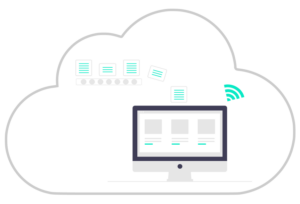Pros and cons of SaaS: Nowadays, companies are constantly looking for innovative solutions to increase efficiency, reduce costs and meet growing demands. SaaS (Software as a Service) turned out to be an extremely attractive option in this regard.

SaaS models do not require a high initial investment in software licenses or hardware. Users usually pay a monthly or annual fee for the use of the software. This allows even small and medium-sized companies to access powerful software without having excessive capital outlays.
With SaaS, the provider takes responsibility for maintaining and updating the software. The user is provided with regular updates and new functions without manually updating the software. This saves time and effort for the internal IT department.
Since SaaS applications are accessible via the internet, users can work from different locations. This provides flexibility and independence of location, allowing users to work and access the system outside of business hours and outside of the company. Furthermore, SaaS applications are platform and operating system independent so they can run on different devices via the web browser as long as there is an internet connection.

Mostly, SaaS applications are developed in a way that they can be easily integrated with other cloud services or tools. This enables companies to connect different applications and share data or processes across them. Good compatibility facilitates the smooth flow of data and efficient collaboration between various systems. For example, calendar tools and project management applications can be linked.
Another advantage of SaaS applications is that they can be implemented quickly as no extensive installation or configuration is required. Thus, companies can access the software quickly and eliminate the need for costly and time-consuming implementation.

While compatibility was mentioned as an advantage, this aspect can also be listed as a disadvantage. Because the compatibility of SaaS applications is not always given and can vary from provider to provider. It is advisable to check compatibility with other important tools and services before selecting a SaaS application to ensure that smooth integration and collaboration are possible. Otherwise, there is the risk that the use of many individual programs will lead to confusion and chaos.
Compared to locally installed software, SaaS applications often offer less adaptability and control. Because the software runs on the provider’s server, users cannot directly access the underlying infrastructure or configuration. The functionality and the design of the software are usually standardized for easy deployment and maintenance. This causes limitations when specific requirements or internal adjustments are needed.
As SaaS applications are cloud-based, a reliable internet connection is essential and a basic requirement for use. If the internet connection is slow and unstable, it can affect the performance and availability of the software and ultimately harm productivity. Therefore, companies must ensure that they have a reliable internet connection to avoid interruptions or loss of productivity.

Switching from one SaaS provider to another can cause data portability problems. Accordingly, it is important to ensure that the data in the SaaS application is always accessible and exportable to ensure a smooth transition. This is because it is not the case for all SaaS applications.
Although SaaS models may seem cost-effective at first, monthly or annual subscription costs can add up over time and become more expensive than purchasing a license for locally installed software. Organizations should carefully analyze and compare long-term costs to ensure that SaaS is the best option in financial terms.

All in all, SaaS undoubtedly offers a variety of benefits including cost efficiency, scalability, flexibility, ease of maintenance and accessibility. However, companies should also consider the potential disadvantages, such as dependence on a stable internet connection and limited customization options. Careful consideration of the specific requirements and risks is crucial to determine if SaaS is the right solution for businesses. It is advisable to conduct a thorough assessment and consider the pros and cons of SaaS in the context of your own business needs to make a suitable decision.
Sign up for an ongoing stream of leading SaaS buying research and resources.
Benefit from the advantages of SaaS! Click here to learn more: